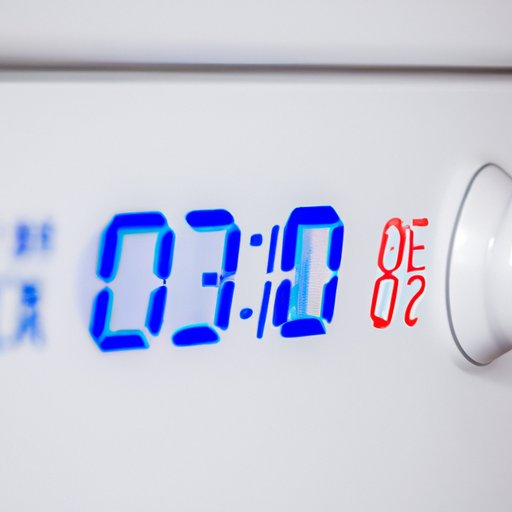Introduction
The temperature of a refrigerator plays a critical role in preserving food quality and keeping it safe from spoilage and contamination. But what is the optimal temperature for a refrigerator, and how can you ensure that your refrigerator is set to the right temperature? This article will explore all aspects of refrigerator temperature, from the ideal temperature range to the different ways to measure and adjust it.

Exploring the Optimal Temperature for a Refrigerator
When it comes to refrigerator temperature, the most important thing to know is that the optimal temperature should be between 34°F and 40°F (1°C and 4°C). This is the ideal range for storing food safely and preventing spoilage and contamination. Anything lower than 34°F could potentially cause freezer burn, while anything higher than 40°F could lead to bacterial growth or food spoilage.
In addition to the optimal temperature range, there are also food safety considerations to keep in mind when setting the temperature of your refrigerator. For example, fresh meats, poultry, and seafood should be stored at temperatures below 40°F, while other items like dairy products, eggs, and leftovers should be stored at temperatures between 32°F and 40°F.

How to Measure and Adjust Refrigerator Temperature
Measuring and adjusting the temperature of your refrigerator is relatively straightforward. The easiest way to do this is to use an appliance thermometer, which can be placed inside the refrigerator to give you an accurate reading of the temperature. In some cases, the exact temperature may not be displayed on the thermometer, but it should still give you a general indication of whether the temperature is too high or too low.
If the temperature is too high or too low, then you can adjust it by using the temperature control dial or buttons on the outside of the refrigerator. Depending on the model, this may be a simple dial or a more advanced digital temperature display. You can usually adjust the temperature in increments of 1°F or 0.5°C, and the optimal temperature should be set somewhere between 34°F and 40°F (1°C and 4°C).
The Science Behind Refrigerator Temperature Regulation
Understanding how a refrigerator regulates its temperature is important for setting and maintaining the optimal temperature. Inside the refrigerator is a thermostat, which is responsible for regulating the temperature. The thermostat measures the temperature inside the refrigerator and then turns the compressor on or off depending on whether the temperature needs to be increased or decreased.
The compressor is the part of the refrigerator that pumps refrigerant gas through the coils, which causes the heat exchange process. The heat exchange process is what cools the air inside the refrigerator and keeps it at a constant temperature. If the thermostat senses that the temperature is too high, it will turn on the compressor to cool the air. If the temperature is too low, it will turn off the compressor to allow the air to warm up.
Understanding Refrigerator Temperature Settings
When setting the temperature of your refrigerator, it’s important to understand the different factors that can affect the temperature settings. These include the size of the refrigerator, the amount of food stored inside, the location of the refrigerator, and the ambient temperature of the room. All of these factors can have an impact on the ideal temperature setting for your refrigerator, so it’s important to take them into consideration when making adjustments.
Most modern refrigerators come with a variety of temperature settings, ranging from as low as 32°F to as high as 50°F. However, the optimal temperature range is between 34°F and 40°F, so it’s best to keep the temperature within this range to ensure food safety and prevent spoilage or contamination.
What You Need to Know About Proper Refrigerator Temperature
Maintaining the proper temperature inside your refrigerator is essential for food safety and quality. To keep food safe, it’s important to follow the guidelines for food storage, such as storing raw meats, poultry, and seafood below 40°F, and storing dairy products, eggs, and leftovers between 32°F and 40°F.
It’s also important to keep in mind that different types of food require different temperatures. For example, fruits and vegetables should be stored at temperatures between 34°F and 40°F, while frozen foods should be stored at temperatures below 0°F. It’s also important to remember that the temperature of your refrigerator can fluctuate due to changes in the ambient temperature of the room, so it’s important to check the temperature regularly.

Maintaining the Perfect Temperature Inside Your Refrigerator
Maintaining the perfect temperature inside your refrigerator can be challenging, but there are a few tips that can help. First, make sure to keep the doors of the refrigerator closed as much as possible to maintain the temperature. Second, avoid overfilling the refrigerator, as this can lead to temperature fluctuations. Third, place a thermometer inside the refrigerator to monitor the temperature. Finally, consider investing in a device that can automatically regulate the temperature of your refrigerator.
There are a variety of products available that can help you monitor and regulate the temperature of your refrigerator. For example, smart thermometers can be used to track the temperature inside the refrigerator and alert you if it gets too hot or cold. There are also devices that can be connected to your refrigerator to help you maintain a consistent temperature. These devices can be programmed to turn the compressor on or off depending on the temperature inside the refrigerator.
Conclusion
Refrigerator temperature plays a critical role in preserving food quality and keeping it safe from spoilage and contamination. The optimal temperature for a refrigerator should be between 34°F and 40°F (1°C and 4°C). It’s important to measure and adjust the temperature regularly, and to follow the guidelines for food storage. Finally, there are a variety of products available that can help you monitor and regulate the temperature of your refrigerator.


